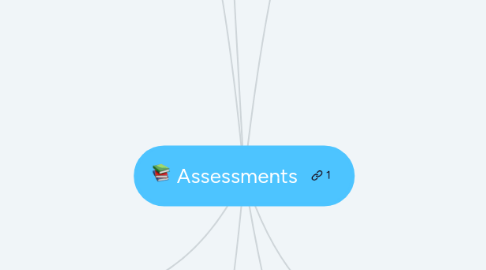
1. Summative
1.1. Planning a summative assessment
1.1.1. End of large chunk (whole group) learning
1.1.2. Review of what you want to do
1.1.3. Criteria for ensuring high-quality assessment
1.1.4. Representative sampling
1.2. Examples of Summative tests
1.2.1. Standardized testing
1.2.2. Final exams
1.2.3. Major cumulative projects
1.2.4. Research projects
1.3. Preparing students
1.3.1. Teach assessment taking skills
1.3.2. Test length, format, types of questions
1.3.3. Review
1.3.4. Item type & format
1.3.5. Assessment anxiety
1.4. Conducting summative assessments
1.4.1. When should they be schedules
1.4.2. When should they be created
1.4.3. Assessment directions
1.4.4. Arrange items
1.4.5. Physical layout
2. WHAT?
2.1. The shared process of gathering purposeful and systematic measurement for documentation, reflection, and improvement of both student learning and institutional practices
3. WHY?
3.1. Helps students learn
3.2. Teacher improve instruction
3.3. Administrators decide how to allocate resources
3.4. Policymakers evaluate the efficacy of education programs
4. Performance
4.1. Individual projects
4.2. Group projects
4.3. Portfolios
4.4. Student Logs
4.4.1. Graphing to show where students are excelling on different assessments
4.5. Journals
4.5.1. Students can write about different main ideas in reading. Students can work on punctuation, spelling, paragraphs, etc.
5. Formative
5.1. Definition:
5.1.1. A way of assessing students while instruction is still in progress
5.2. Examples:
5.2.1. exit slips
5.2.2. thumbs up, thumbs down
5.2.3. Think-pair-share
5.3. Characteristics:
5.3.1. Evidence of students learning
5.3.2. Structure
5.3.3. participants involved in feedback
5.3.4. instruction adjustments
5.3.5. Teacher-student interaction
5.4. 6 Different forms of formal formative assessments:
5.4.1. Structured exercises
5.4.2. Pretests
5.4.3. Homework
5.4.4. In class assignments
5.4.5. Quizzes and unit tests
5.4.6. Classroom response systems
5.5. Informal formative assessment types:
5.5.1. Informal observations
5.5.2. Questioning
5.5.3. Spontaneous
5.5.4. Immediate feedback and adjust instruction
5.6. Formative assessment cycle:
5.6.1. Gather evidence of learning
5.6.2. Evaluate evidence
5.6.3. Feedback
5.6.4. Adjust instruction
6. Interim/Benchmarks
6.1. Periodic testing throughout the school year
6.1.1. every six weeks

